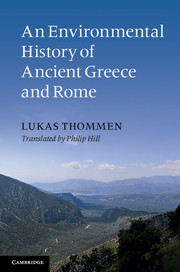Book contents
- Frontmatter
- Contents
- Figures
- Preface
- Introduction
- Part I Greece
- Chapter 1 The geographic space
- Chapter 2 People and nature
- Chapter 3 Agriculture
- Chapter 4 Forests and timber
- Chapter 5 Gardens
- Chapter 6 Animals
- Chapter 7 Food
- Chapter 8 Fire and water
- Chapter 9 Earthquakes and volcanoes
- Chapter 10 Mining
- Part II Rome
- Chronology
- Further reading
- Sources
- Bibliography
- Index
Chapter 10 - Mining
Published online by Cambridge University Press: 05 June 2012
- Frontmatter
- Contents
- Figures
- Preface
- Introduction
- Part I Greece
- Chapter 1 The geographic space
- Chapter 2 People and nature
- Chapter 3 Agriculture
- Chapter 4 Forests and timber
- Chapter 5 Gardens
- Chapter 6 Animals
- Chapter 7 Food
- Chapter 8 Fire and water
- Chapter 9 Earthquakes and volcanoes
- Chapter 10 Mining
- Part II Rome
- Chronology
- Further reading
- Sources
- Bibliography
- Index
Summary
Ancient society had a high demand not only for wood, but also for rock and clay for construction, and for metals, which were used for all sorts of purposes in the trades and in artistic work. Clay and rock were quarried at the surface; the quarries were as a rule in the near vicinity of the cities. The best known marble quarries were in the Pentelikon Mountains near Athens, on the Cycladic islands of Paros and Naxos, and in the Peloponnese. Moreover, gold, silver, tin, copper, lead and iron were mined in various places, often in subterranean mines. Owing to the scarcity of resources and the high procurement costs, quite a number of materials and products were repeatedly reused throughout antiquity (Hdt. 3.6).
Metals had been mined in Greece, Asia Minor, Dacia and Spain since the Neolithic era, with copper and tin, for which Britain was famous, the most important products (Strab. 4.5.2; Diod. 5.22.1ff., 38.4–5; Tac. Agr. 12.6). Since the third millennium bc, bronze had been produced as an alloy of copper and tin, and Cyprus early developed into a leading centre for copper mining. Silver was mined in large quantities on the Aegean island of Siphnos (Hdt. 3.57–8; Paus. 10.11.2), as was gold on the island of Thasos, where the entire Mount Scapte Hyle was supposedly deforested and dug up (Hdt. 6.46–7).
- Type
- Chapter
- Information
- An Environmental History of Ancient Greece and Rome , pp. 62 - 66Publisher: Cambridge University PressPrint publication year: 2012



